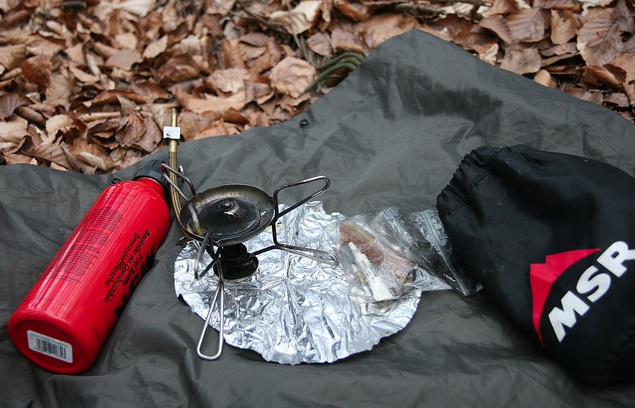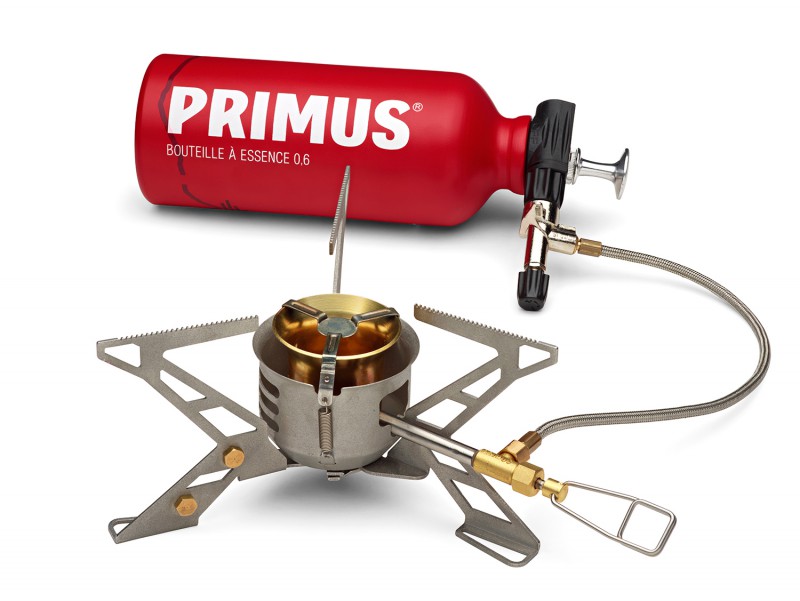Get the weekly SPARTANAT newsletter.
Your bonus: the free E-Book from SPARTANAT.

When it comes to multi-fuel burners, there are just as many manufacturers as with the stoves already presented, the widely known and established ones are MSR and Primus. These burners can burn petrol, diesel, oil, spirit, kerosene, paraffin and in principle also gas, if supplied in appropriate containers. The fuel is transported in a bottle and pressurized before use using a small hand pump; you may need to pump it up again during prolonged use, even while cooking.
The functionality is essentially the same for all types: a bit of fuel is used to heat up a vaporizer device (usually just the fuel line). When this device is hot enough, fuel is introduced, vaporized (turning liquid fuel into a gas-air mixture), and then burned further through a nozzle. (At very low temperatures, pay attention to the viscosity of the fuel; if necessary, preheat the fuel line with Esbit tablets)
Manufacturers almost universally recommend using pure petrol/lighter fluid as it burns the cleanest. When using other fuels, the nozzle can sometimes get sooty and needs cleaning. (MSR offers "self-cleaning" nozzles which can delay the cleaning process, but cannot completely prevent it.) However, each stove usually comes with a small maintenance kit and it is advisable to familiarize yourself with the stove before the trip in order to perform basic maintenance tasks.
Unleaded regular gasoline (or E10) is generally the most reliable option; premium gasoline contains too many additives, diesel produces more soot and is harsher on seals, and lighter fluid is excessively expensive, although it works fine with various other fuels. Regular gasoline is simply widely available and not too dirty.
For diesel, light oil, kerosene, etc., it's generally advisable to use slightly larger nozzles provided by the manufacturer, as otherwise the maintenance intervals will be significantly shorter due to nozzle clogging.
Depending on the fuel used, you'll get a very good calorific value across all temperature ranges, and fuels like petrol or diesel are widely available worldwide (although it is recommended to use a separate fuel bottle for each type of fuel and not mix them).
 The burner models have different levels of control, where specialized stores can provide assistance.
The burner models have different levels of control, where specialized stores can provide assistance.
All burner types have in common (unless they are connected to a gas bottle) that they produce a lot of soot during preheating and have a rather loud burning noise during operation.
Furthermore, their handling is unconventional and compared to all other types of burners, they are slow and complicated.
Overall, it's a versatile type of burner, but due to the high initial costs and the more complex maintenance and operation, it may be uninteresting for occasional users, but suitable for longer trips to remote areas or cold climates.
Make sure not to confuse these fuel bottles with drinking bottles!
Initial costs range from about 80€ to 300€ + fuel (depending on fuel prices …)
Barthel
All about Hobbies - HERE is the first part of the article.
All about Solid Fuel Burners - HERE is the second part of the article
All about Gas Stoves - HERE is the third part of the article
To be continued
SPARTANAT is the online magazine for Military News, Tactical Life, Gear & Reviews.
Send us your news: [email protected]
Ad
similar
Get the weekly SPARTANAT newsletter.
Your bonus: the free E-Book from SPARTANAT.


